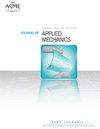Energy Dissipation on an elastic interface as a metric for evaluating three friction models
IF 2.8
4区 工程技术
Q2 MECHANICS
引用次数: 0
Abstract
The effect of three different friction interface models on an elastic half-space is presented. Three constitutive friction models are studied: Coulomb, Soil-Concrete Interface and Bouc-Wen, using a computational mechanics framework that can represent the contact patch's material response to static and dynamic surface tractions. This response is observed as strains and stresses present from reciprocating sliding using an elasto-plastic friction(EPF) algorithm that also captures energy dissipation and hysteresis due to friction sliding. Additionally, the use of the 4-parameter Bouc-Wen model represents a new development in contact mechanics that allows microslip of the contact interface to be modeled. Hysteresis loops are generated for the three friction models based on a quasi-static assumption. This algorithm is built into a meso-scale FEM solver that is able to simulate different loading conditions and provide insight about how the friction models respond to load conditions and inform on experimental data. The energy dissipation from reciprocating friction sliding will be generated for each friction model as a metric that captures surface wear and potentially material damage.弹性界面上的能量耗散作为评价三种摩擦模型的度量
给出了三种不同摩擦界面模型对弹性半空间的影响。研究了三个摩擦本构模型:库仑、土-混凝土界面和Bouc-Wen,使用了一个计算力学框架,该框架可以表示接触片对静态和动态表面牵引的材料响应。这种响应是使用弹塑性摩擦(EPF)算法作为往复滑动产生的应变和应力来观察的,该算法还捕捉了由于摩擦滑动引起的能量耗散和滞后。此外,4参数Bouc-Wen模型的使用代表了接触力学的一个新发展,它允许对接触界面的微滑移进行建模。基于准静态假设,生成了三个摩擦模型的磁滞回线。该算法内置于中尺度有限元求解器中,该求解器能够模拟不同的载荷条件,并提供关于摩擦模型如何响应载荷条件的见解,并为实验数据提供信息。将为每个摩擦模型生成往复摩擦滑动的能量耗散,作为捕捉表面磨损和潜在材料损伤的指标。
本文章由计算机程序翻译,如有差异,请以英文原文为准。
求助全文
约1分钟内获得全文
求助全文
来源期刊
CiteScore
4.80
自引率
3.80%
发文量
95
审稿时长
5.8 months
期刊介绍:
All areas of theoretical and applied mechanics including, but not limited to: Aerodynamics; Aeroelasticity; Biomechanics; Boundary layers; Composite materials; Computational mechanics; Constitutive modeling of materials; Dynamics; Elasticity; Experimental mechanics; Flow and fracture; Heat transport in fluid flows; Hydraulics; Impact; Internal flow; Mechanical properties of materials; Mechanics of shocks; Micromechanics; Nanomechanics; Plasticity; Stress analysis; Structures; Thermodynamics of materials and in flowing fluids; Thermo-mechanics; Turbulence; Vibration; Wave propagation

 求助内容:
求助内容: 应助结果提醒方式:
应助结果提醒方式:


